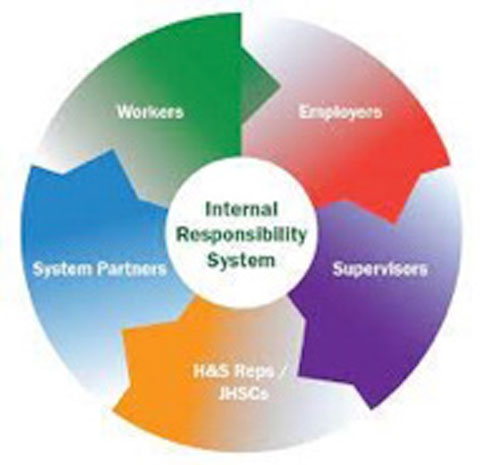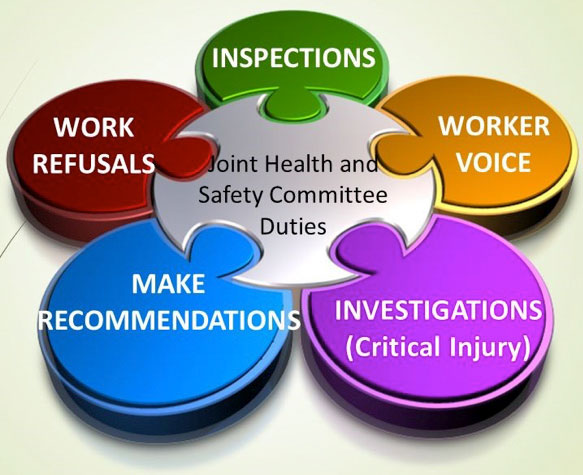Joint Health & Safety Committee
By Laurel Woodhouse, Health and Safety Manager

What is a Joint Health and Safety Committee?
A joint health and safety committee ( JHSC) is a forum for bringing the internal responsibility system into practice.
The committee consists of labour and management representatives who meet on a regular basis to deal
with health and safety issues.
The advantage of a joint committee is that the in-depth practical knowledge
of specific tasks (labour) is brought together with the larger overview of company policies, and procedures
(management). Another significant benefit is the enhancement of cooperation among all parts of the work force toward solving health and safety problems. In smaller companies with fewer than a specified number of employees, a health and safety representative is generally required. Consult health and safety legislation applicable to your workplace for details.
Who is responsible for establishing a JHSC?
Employer
What does the JHSC do?
• Recognize workplace hazards
• Evaluate the hazards and risk that may cause incidents, injuries and illness
• Participate in development and implementation of programs to protect the employees’ safety and health
• Respond to employee complaints and suggestions concerning safety and health
• Ensure the maintenance and monitoring of injury and work hazards records
• Monitor and follow-up hazard reports and recommend action
• Set up an promote programs to improve employee training and education
• Participate in safety and health inquires and investigations, as appropriate (Not Workplace Violence and Harassment investigations – for confidentiality reasons)
• Consult with professional and technical experts
• Participate in resolving workplace refusals and work stoppages
• Make recommendation to management for incident prevention and safety program activities.
• Monitor effectiveness of safety programs and procedures

When are JHSC required, and how many people are on the committee?
Legislation Requirements for Health and Safety Committees
| When do I need one? | Size of Committee | Representation | |
|---|---|---|---|
| Canada | Mandatory – 20 or more employees | At least 2 | At least half to represent employees |
| British Columbia | Mandatory – when there are 20 or more employees or when “required by order” | Not less than 4 | At least one half must be worker representatives |
| Alberta | Mandatory – 20 or more employees, or when ordered by Minister, or where a designated substance is in use (no minimum number of employees) | At least 2 (fewer than 50 employees); At least 4 (50 or more employees | At least half to represent employees |
| Quebec | 20 or more employees and where required by CNESST* | At least 4 | At least half to represent employees |
| New Brunswick | Mandatory – 20 or more employees | As agreed upon by employees and employer | Equal Representation |
| Nova Scotia | Mandatory – 20 or more employees | As agreed upon by employees and employer | At least half to represent employees |
Who sit on our ASP SAFETY Committees?
• YYC –Management Matt Szajkowski, Tamara Juniper Employees Radowan Chowdhury, and Mohamad Miah
• YSB – Not required under 20 employees
• YYZ – Employees Yavar Qadri, Ethilda Donkor, Sayeed Khan, Management Noman Butt, Jason Zapata and Laurel Woodhouse
• RES /CIC–Will be holding an election in the near future
• Crossing Guards – in-active until September 2021
• K9 – Will be holding an election in the near future
• YOW – Closed
• Billy Bishop Airport – Closed
Something to keep in mind about safety committees.
• In most Canadian jurisdictions, the legally recognized communication channel on safety matters is between the worker and the supervisor. Workers are to report unsafe acts and conditions initially to their immediate supervisor. The supervisor is responsible for acting on such reports and for directing safe work procedures. Committee members should not interfere with this process, except under special circumstances, such as cases of imminent danger where immediate corrective action is necessary.
• It must be clearly understood by all concerned that the employer’s responsibility for safety is in no way diluted or diverted with the formation of a joint health and safety committee.
• Ensuring compliance with safety regulations and procedures is the supervisor’s job while the committee member’s role is more that of an observer and advisor.
• Effective two-way communication ensures that workers are aware of committee activities and gives them an opportunity to contribute ideas to the committee.
• UNIONIZED SETTINGS: Union support of its members on a joint health and safety committee can be evaluated by the way in which members are appointed, the amount of education provided on union health and safety policies, assisting the attendance of members to health and safety seminars, and help given in situations where a problem has occurred in making committee recommendations.
https://www.ccohs.ca/oshanswers/hsprograms/hscommittees/measure.html
